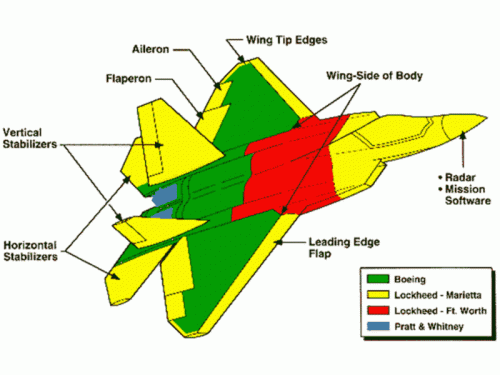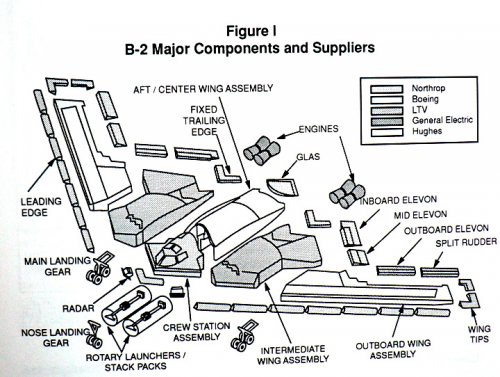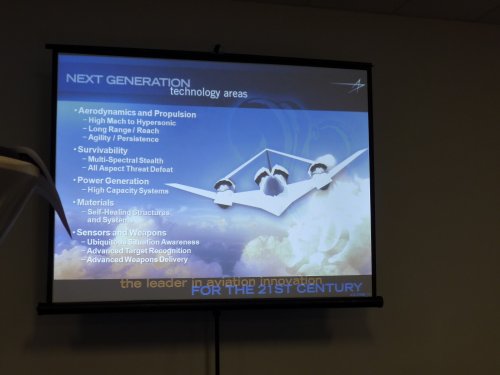With that firmly in mind, the Lockheed-Boeing-General Dynamics Team began work at the crack of dawn on Monday, Nov. 3, 1986. I was now running a powerful team, and although we hardly knew each other that changed quickly. I was determined to use Skunk Works program management methods as much as possible in this complicated team lash-up.
USAF designated our team’s ATF the F-22 and the Northrop team’s airplane the F-23. The Dem/Val round of the competition was set to last 50 months and end Dec. 31, 1990.
The broad Air Force requirements were well thought out, focused, comprehensive, and extremely demanding. The average production cost was not to exceed $35 million per airplane. The maximum gross takeoff weight was not to exceed 50,000 pounds. The aircraft was to be very stealthy, be able to supercruise, have excellent maneuverability, and have a very advanced integrated avionics system. It was to be superior to the F-15 Eagle by a large margin: more reliable, easier to maintain, and far easier to support when operating deployed anywhere on Earth. Other than that, we could do anything to the design we thought was the right engineering thing to do. The airplane was to be a “clean sheet of paper” design. Everything in it would be new. This turned out to be very hard work—sometimes almost unbearable, but sometimes joyous.
The prototyping of the aircraft and avionics system were “best efforts” programs, aimed at reducing risk in the production phase of the program. There were no detailed contract specifications, just a general statement of requirements. One exception was the maneuvering capability, which USAF specified in more detail than any other performance requirement. It was clear that the Air Force was insisting on outstanding fighter combat maneuvering performance and would not allow it to be compromised to achieve the demanding stealth objectives. This did not change during the four-year competition.
Employing the “best efforts” approach meant that our team had to decide what we would do and what we would not do. Example: We decided that one of our prototype aircraft would have missile launch capability, which was not required. In the case of the avionics system, our team and its subcontractors had to decide what avionics equipment and how much mission software to prototype. Early in the program we strenuously debated and rapidly resolved these issues. And, once resolved, they were not changed. (We later realized our team had made some very good decisions in 1987.)
Launching the F-22 Team
For about 100 key members of the Lockheed-Boeing-General Dynamics F-22 Team Nov. 3-7, 1986, was a memorable week, with some truly new experiences. The team gathered in Burbank on Sunday evening, Nov. 2, ready for the kickoff meeting on Nov. 3. It was a unique experience for everyone, an all day long show and tell, with each company summarizing its own proposal.
On Thursday, Nov. 6, Eric “Rick” E. Abell, Technical Director (Chief Engineer) of the Air Force ATF System Program Office (SPO), gave the team management a formal debrief of the Air Force’s assessment of the proposals that had been presented by each of the three companies. He specifically cited their strengths and weaknesses. It was clear that the Lockheed Systems Engineering volume and detailed risk re- duction plans had been a significant factor in the Lockheed win. Abell impressed the F-22 Team with his straight forward approach, frankness, and objectivity. This impression of him would not change over the next 50 months.
As the Team Program Office General Manager, I had the Boeing, General Dynamics, and Lockheed Program Managers reporting directly to me.
Dick Hardy. Boeing Program Manager Hardy had come to Boeing as an aeronautical engineer directly out of MIT in 1959. He was tersely articulate, strong minded, very systematic, and, it turned out, very loyal. His will to win was very strong. Like me, he was a native Northeasterner who had become a permanent Westerner.
Randy Kent. Kent, the General Dynamics Vice President and F-22 Program Director, had been a combat infantryman in Europe in World War II. He was a veteran aero- dynamicist, very analytical, and a very experienced engineer and manager. He had by far the most fighter aircraft development experience in our team program office and was out to win in this last competition of his career.
Jack Gordon. Gordon, who had been the Skunk Works Chief Engineer for the F- 117A, became the Lockheed F-22 Program Manager. He had 23 years aerospace experience and a Stanford master’s degree in mechanical engineering. He was a strong, confident manager, solid as a rock. He helped significantly in launching the F-22 program before he became Assistant General Manager of Skunk Works.
Bob Blanchard. Blanchard continued as Lockheed F-22 Vice President and the team’s Assistant General Manager.
We became a very cohesive management team, working intensely together, with mutual respect and mutual support. Our emotional commitment to winning the competition was very strong.
Team Relationships
We ran the F-22 team as a tightly knit—really tight—joint venture. This is an easy statement to make. What made it a reality every day for the entire 50 months was the relationship of Hardy, Kent, and me. All decisions and direction were made by us jointly in real time—often only in verbal form. At Boeing in Seattle, General Dynam- ics in Fort Worth, and Lockheed in Burbank, the F-22 had separate, classified work areas with security guards. The Team Program Office managed all work, not local company management, although they sometimes rose up and had to be put down.
The ExCom repeatedly urged me to divorce myself from internal Lockheed opera- tions—I did, but the withdrawal took awhile—to spend all my time and energy lead- ing the team. In the last years of the competition, I did not go to any Lockheed staff meetings and refused to be involved in any Lockheed activities not directly related to the ATF competition.
Within the F-22 Team, we had our own simple operating policies and procedures, none of which were well documented or followed rigorously. However, our paramount driver was time—and we did not let anybody take it away from us.
As agreed in the Teaming Agreement, each company was to get one third of the work by dollar value, meaning that each committed to making 33 percent of the investment. I did not attempt to use standard Lockheed subcontracting policies and procedures. And, there was no effort spent deciding who shot John when problems popped up that would cost money to fix. (There were plenty of them.)
The equal one-third split really helped build team cohesiveness. It also precluded having administrators and lawyers—generating piles of paperwork—fight over who was going to pay what bill. We each paid 33 percent of the total bill and that was that. The team had few paper shufflers—a damned delight.
Our goal was to have completely open relationships within the team and with the Air Force across all elements of the program: technical performance, detailed plans and schedules, budgets, and financial performance. This proved painful sometimes, but that was the way we operated.
Blanchard, by far the most experienced subcontracting manager in the Team Pro- gram Office, was the chief architect for the team approach to subcontracting, which was straightforward: Any company that won an F-22 subcontract would advance with us if the F-22 Team won. They needed that assurance since most subcontracts were fixed price, requiring the subcontractor to invest. The only catch: The subcon- tractor had to deliver in this final selection phase. This way the Air Force would get what might be called a package deal.
We maintained very close relationships with the major subcontractors at all levels, frequently violating policy by circumventing the management chain of command. However, we trusted them and they trusted us.
We also had very close relationships, at all levels, with the competing jet engine contractors—General Electric and Pratt & Whitney. Both were designing low observ- able engine exhaust nozzles to meet our specific requirements. We trusted them to protect our competitively sensitive information and vice versa. We developed very strong program management and engineering bonds with both engine companies.
As part of the F-22 Team operating mode, we made no effort to gather competi- tive intelligence and perform competitive analysis. We simply ignored the Northrop- McDonnell Douglas F-23 team. We had decided that the right strategy was to focus on what the Air Force wanted and, if possible, give it to them. There would be no gamesmanship, no political persuasion. We did briefly debate conducting a sub- stantial advertising campaign, but both the ExCom and the F-22 Team Program Office saw no value in it.
The three company CEOs and the ExCom were critical in keeping the many non- ATF managers out of the F-22 Team’s way. These top execs managed that nearly flawlessly throughout the program. One succeeded totally: Boeing CEO Frank A. Schrontz, who was the only CEO in office throughout the program, would ask me privately, whenever he saw me, if I was having a problem with anyone in Boeing; my answer was always no.



